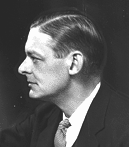|
● Early
Fiction
● Transcendentalists
● Power
of Imagination
● New
Visions of America
● Reform
and Liberation
● Regionalism
● A
New Wave
● Sympathetic
Views
● Rebellious Spirit
● The
Modernists
● The Lost Generation
● Harlem Renaissance
● New
Drama
● Depression,
Realism and Escapism
● Postwar Voices
and the "Beat Generation"
● New American
Voices
The Modernists
 One
important literary movement of the time was "Imagism,"
whose poets focused on strong, concrete images. Ezra
Pound began as an Imagist but soon went beyond, into complex,
sometimes obscure poetry, full of references to other
art forms and to vast range of literature. Living in Europe, Pound
influenced many other poets, especially T.S.
Eliot. One
important literary movement of the time was "Imagism,"
whose poets focused on strong, concrete images. Ezra
Pound began as an Imagist but soon went beyond, into complex,
sometimes obscure poetry, full of references to other
art forms and to vast range of literature. Living in Europe, Pound
influenced many other poets, especially T.S.
Eliot.
 |
|
T.S.Eliot
|
 Eliot
wasborn in St. Louis but settled in England. He wrote spare,
intellectual poetry, carried by a dense structure of symbols.
His
1922 poem, The Waste Land spun out, in fragmented, haunting images,
a pessimistic vision of post-World War I society. From
then on, Eliot dominated the so-called "Modern" movement
in poetry. Another Modernist, E.E.Cumming, called attention to his
poetry by throwing away rules of punctuation, spelling, and even
the way words were placed on the page. His poems were songlike but
satiric, humorous and anarchistic. Wallace Stevens, in contrast,
wrote thoughtful speculations on how man can know reality.
Stevens's verse was disciplined, with understated rhythms, precisely
chosen words and a cluster of central images. The poetry
of William Carlos Williams, with its light, supple rhythms,
was rooted in Imagism, but Williams, a New Jersey physician, used
detailed impressions of everyday American life. Eliot
wasborn in St. Louis but settled in England. He wrote spare,
intellectual poetry, carried by a dense structure of symbols.
His
1922 poem, The Waste Land spun out, in fragmented, haunting images,
a pessimistic vision of post-World War I society. From
then on, Eliot dominated the so-called "Modern" movement
in poetry. Another Modernist, E.E.Cumming, called attention to his
poetry by throwing away rules of punctuation, spelling, and even
the way words were placed on the page. His poems were songlike but
satiric, humorous and anarchistic. Wallace Stevens, in contrast,
wrote thoughtful speculations on how man can know reality.
Stevens's verse was disciplined, with understated rhythms, precisely
chosen words and a cluster of central images. The poetry
of William Carlos Williams, with its light, supple rhythms,
was rooted in Imagism, but Williams, a New Jersey physician, used
detailed impressions of everyday American life.
Previous Page Next
Page
|

